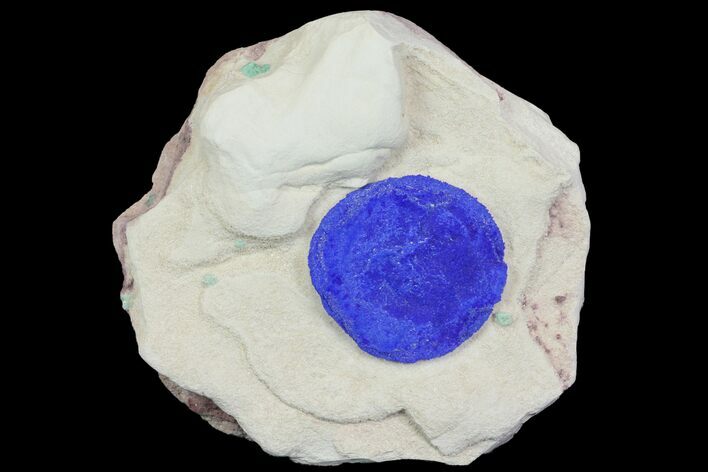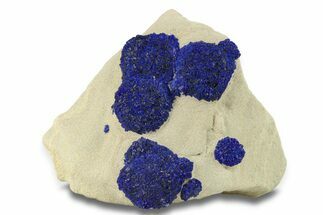This Specimen has been sold.
1.4" Azurite Sun and Malachite on Siltstone - Australia
This is a 1.4" wide, brilliant blue azurite sun on a kaolinitic siltstone/sandstone matrix. It was collected from the Malbunka Copper Mine in the Northern Territory of Australia. There are malachite formations scattered throughout the siltstone as well.
It comes with an acrylic display stand.
It comes with an acrylic display stand.
Azurite is a deep blue copper-based mineral produced by the oxidation of copper ore deposits. Azurite suns are a unique formation of this mineral, only found in a single mine: the Malbunka Copper Mine in Australia. These suns form between layers of a clay mineral called kaolinite (the white matrix the suns are on).
They are thought to have been formed by hydrothermal fluids carrying copper ions through bedding planes in the rock formation. Carbonate molecules and copper ions in the groundwater nucleated around mineral grains in the kaolinite, which caused the azurite to crystallize. Because the azurite was forced to grow in a laterally-compressed and radiating manner along preferred bedding planes, the azurite grew uniformly outward, often producing circular shapes.
They are thought to have been formed by hydrothermal fluids carrying copper ions through bedding planes in the rock formation. Carbonate molecules and copper ions in the groundwater nucleated around mineral grains in the kaolinite, which caused the azurite to crystallize. Because the azurite was forced to grow in a laterally-compressed and radiating manner along preferred bedding planes, the azurite grew uniformly outward, often producing circular shapes.
About Malachite
Malachite is an intense green copper-based mineral that can be found in a wide variety of forms. Malachite can grow in botryoidal masses, stalactitic formations, and reniform formations, typically as a tight cluster of fanning fibrous needles that make up a seemingly solid mass. As layers continue to stack during formation, banded patterns can sometimes begin to take shape, explaining the rings in all shades of green seen on most polished malachite specimens.
Malachite results from the weathering of other copper ores, and is very often found associated with other copper-based minerals such as azurite and chrysocolla. It can be found in copper deposits around the world, but the Democratic Republic of the Congo is the primary source for polished malachite and mineral specimens.
Malachite has been prized since ancient times, first as a utilitarian copper ore, then as an ornamental stone. Due to its value as a decorative stone, it is rarely mined as a copper ore anymore.
Malachite is an intense green copper-based mineral that can be found in a wide variety of forms. Malachite can grow in botryoidal masses, stalactitic formations, and reniform formations, typically as a tight cluster of fanning fibrous needles that make up a seemingly solid mass. As layers continue to stack during formation, banded patterns can sometimes begin to take shape, explaining the rings in all shades of green seen on most polished malachite specimens.
Malachite results from the weathering of other copper ores, and is very often found associated with other copper-based minerals such as azurite and chrysocolla. It can be found in copper deposits around the world, but the Democratic Republic of the Congo is the primary source for polished malachite and mineral specimens.
Malachite has been prized since ancient times, first as a utilitarian copper ore, then as an ornamental stone. Due to its value as a decorative stone, it is rarely mined as a copper ore anymore.
SPECIES
Azurite & Malachite
LOCATION
Malbunka Copper Mine, Utju, Northern Territory, Australia
SIZE
1.4" Azurite sun on Matrix 3.4 x 3.25"
CATEGORY
SUB CATEGORY
ITEM
#142788
 Reviews
Reviews














